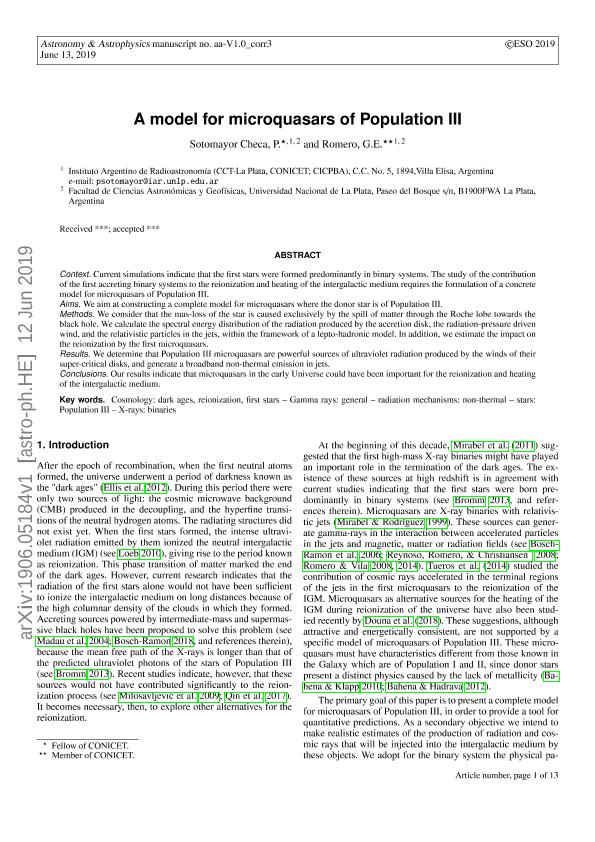Mostrar el registro sencillo del ítem
dc.contributor.author
Sotomayor Checa, Pablo Omar

dc.contributor.author
Romero, Gustavo Esteban

dc.date.available
2020-08-07T17:19:52Z
dc.date.issued
2019-09
dc.identifier.citation
Sotomayor Checa, Pablo Omar; Romero, Gustavo Esteban; Model for Population III microquasars; EDP Sciences; Astronomy and Astrophysics; 629; 9-2019; 1-13
dc.identifier.issn
0004-6361
dc.identifier.uri
http://hdl.handle.net/11336/111184
dc.description.abstract
Current simulations indicate that the first stars were formed predominantly in binary systems. The study of the contribution of the first accreting binary systems to the reionization and heating of the intergalactic medium requires the formulation of a concrete model for microquasars of Population III. We aim at constructing a complete model for microquasars where the donor star is of Population III. We consider that the mas-loss of the star is caused exclusively by the spill of matter through the Roche lobe towards the black hole. We calculate the spectral energy distribution of the radiation produced by the accretion disk, the radiation-pressure driven wind, and the relativistic particles in the jets, within the framework of a lepto-hadronic model. In addition, we estimate the impact on the reionization by the first microquasars. We determine that Population III microquasars are powerful sources of ultraviolet radiation produced by the winds of their super-critical disks, and generate a broadband non-thermal emission in jets. Our results indicate that microquasars in the early Universe could have been important for the reionization and heating of the intergalactic medium.
dc.format
application/pdf
dc.language.iso
eng
dc.publisher
EDP Sciences

dc.rights
info:eu-repo/semantics/openAccess
dc.rights.uri
https://creativecommons.org/licenses/by-nc-sa/2.5/ar/
dc.subject
Cosmology
dc.subject
Gamma rays
dc.subject
Radiation mechanisms
dc.subject
Population III stars
dc.subject
X-rays binaries
dc.subject
Dark ages
dc.subject
Reionization
dc.subject
First stars
dc.subject
Non-thermal mechanisms
dc.subject.classification
Astronomía

dc.subject.classification
Ciencias Físicas

dc.subject.classification
CIENCIAS NATURALES Y EXACTAS

dc.title
Model for Population III microquasars
dc.type
info:eu-repo/semantics/article
dc.type
info:ar-repo/semantics/artículo
dc.type
info:eu-repo/semantics/publishedVersion
dc.date.updated
2020-08-04T19:36:47Z
dc.journal.volume
629
dc.journal.pagination
1-13
dc.journal.pais
Francia

dc.description.fil
Fil: Sotomayor Checa, Pablo Omar. Provincia de Buenos Aires. Gobernación. Comisión de Investigaciones Científicas. Instituto Argentino de Radioastronomía. Consejo Nacional de Investigaciones Científicas y Técnicas. Centro Científico Tecnológico Conicet - La Plata. Instituto Argentino de Radioastronomía; Argentina
dc.description.fil
Fil: Romero, Gustavo Esteban. Provincia de Buenos Aires. Gobernación. Comisión de Investigaciones Científicas. Instituto Argentino de Radioastronomía. Consejo Nacional de Investigaciones Científicas y Técnicas. Centro Científico Tecnológico Conicet - La Plata. Instituto Argentino de Radioastronomía; Argentina
dc.journal.title
Astronomy and Astrophysics

dc.relation.alternativeid
info:eu-repo/semantics/altIdentifier/url/https://www.aanda.org/10.1051/0004-6361/201834191
dc.relation.alternativeid
info:eu-repo/semantics/altIdentifier/doi/http://dx.doi.org/10.1051/0004-6361/201834191
Archivos asociados
